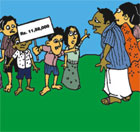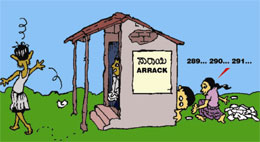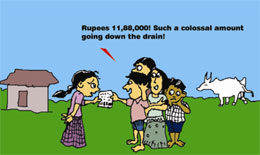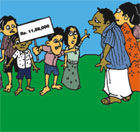New manual for community involvement from CWC, India
Children as agents of change
Children can make a real difference in their communities. A new manual on rights-based research from Concerned for Working Children (CWC) in Bangalore, India shows how children can be empowered to influence their community and also local alcohol policies.
 The research manual is developed on the basis of activities conducted by children in Keradi in the Indian state of Karnataka. These children, with the support of adult facilitators, took all the necessary steps to influence the policy of their local government (Grama panchayat/ Grama sabha) and the social life of the village: Defining the problem they faced. Finding adequate working methods. Collecting local data. Compiling and analysing the data. Drawing of conclusions. Advocacy towards adults and political leaders in the community. Getting tangible results.
The research manual is developed on the basis of activities conducted by children in Keradi in the Indian state of Karnataka. These children, with the support of adult facilitators, took all the necessary steps to influence the policy of their local government (Grama panchayat/ Grama sabha) and the social life of the village: Defining the problem they faced. Finding adequate working methods. Collecting local data. Compiling and analysing the data. Drawing of conclusions. Advocacy towards adults and political leaders in the community. Getting tangible results.
The child rights organisation Concerned for Working Children has developed a manual based on the experiences with the children from Keradi. CWC now has made their manual available to other NGOs which aim to involve children in documentation and advocacy work.
The manual can be downloaded here.
Here is a two minutes video film presenting the case.
Read more about Concerned for Working Children at their web site here.
“Amazing”
 “The experiences have been both exhilarating and educative for adults”, says Kavita Ratna, Director of Communications of CWC. “The precision and dedication with which these children have followed the steps of research, the honesty they have exhibited and their need for seeking the truth has been amazing. They had the urgency to act on the information they had gathered and eagerness to share the information with their peers and community”. (Kavita Ratna to the left in the picture)
“The experiences have been both exhilarating and educative for adults”, says Kavita Ratna, Director of Communications of CWC. “The precision and dedication with which these children have followed the steps of research, the honesty they have exhibited and their need for seeking the truth has been amazing. They had the urgency to act on the information they had gathered and eagerness to share the information with their peers and community”. (Kavita Ratna to the left in the picture)
Nandrolli is a small hamlet in Keradi in Udupi Taluk, a remote village located on the Western Ghats in Karnataka, India. It has 75-80 families and a population of 400 to 450.Alcoholism was a way of life and a major issue in this area. Thewomen and children especially suffered on account of alcohol abuse. This created tension and disharmony in the families and in the larger community.
Brushed aside
These children of Keradi, who are members of Makkala Panchayat (a children's organisation), had faced a lot of problems. They started talking to each other and decided that they had to find a solution to this menacing problem. Children had tried to raise this issue with the members of Adult Grama Panchayat (local government) before, but they had been brushed aside saying that it was not really an issue and that there was no need for children to tell adults about it. Faced with such resistance the children concluded that they needed to define a strategy and to equip themselves with facts and information about the real situation in their community.
The question was then: How to find facts that could show the real size of alcohol consumption in the village and which could make adults re-think about the seriousness of the problem. The children decided that under the pretext of a ‘clean the village’ campaign, they would clean the surroundings of the main ‘arrack shop’ in the hamlet. They were sure that this strategy would get them the required information.
Count of arrack sachets
 Their research method was to count the arrack sachets strewn around the arrack shop. On the first day they cleaned up the entire area surrounding the arrack shops in Nandrolli. Once all the sachets were cleared, they continued their cleaning activity, not only for one or two more days but for an entire week. They also made sure their counting included a festival day and a Saturday, which was the payment day for all the factory workers and labourers. So each day morning children collected all the empty sachets of arrack surrounding the arrack shop and counted them. While on some days, especially the festival day and Saturday, they got more number of packets compared to other week days.
Their research method was to count the arrack sachets strewn around the arrack shop. On the first day they cleaned up the entire area surrounding the arrack shops in Nandrolli. Once all the sachets were cleared, they continued their cleaning activity, not only for one or two more days but for an entire week. They also made sure their counting included a festival day and a Saturday, which was the payment day for all the factory workers and labourers. So each day morning children collected all the empty sachets of arrack surrounding the arrack shop and counted them. While on some days, especially the festival day and Saturday, they got more number of packets compared to other week days.
A huge amount
 Finally they took the average of all the 7 days’ count. They found that an average of 300 packets of arrack are consumed per day. Then they made their calculations. A packet of arrack costs Rupees 11.00. Three hundred packets cost Rs. 3300.00. This worked out to Rs.99, 000.00 per month and Rs.11, 88,000.00 per year. This was a huge amount for only a small hamlet with a total population of about 400 to 450 people.
Finally they took the average of all the 7 days’ count. They found that an average of 300 packets of arrack are consumed per day. Then they made their calculations. A packet of arrack costs Rupees 11.00. Three hundred packets cost Rs. 3300.00. This worked out to Rs.99, 000.00 per month and Rs.11, 88,000.00 per year. This was a huge amount for only a small hamlet with a total population of about 400 to 450 people.
The rest of this inspiring story can be read in the CWC manual “Children as research protagonists! Rights-Based Research by Children”. Together with the full story the reader will find methodological comments all along, comments which make it easer for others to use the same technique in empowering and mobilising children.
RELATED ARTICLES
- New report highlights benefits of policy measures to prevent harmful alcohol consumption
- Highlighting the COVID-19 – alcohol connection
- Alcohol among risk factors increasing
- WHO Launches Global status report on alcohol and health 2018
- Effective alcohol policies are needed now to yield health benefits in the future
- Alcohol as an obstacle to development
- Empowerment of children is key in drug prevention
- Alcohol use a significant cancer risk factor
- New policy programmes and a new leadership
- Prevention Works

